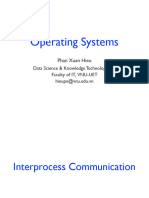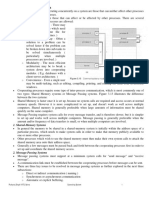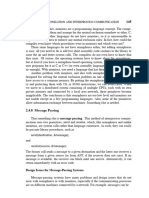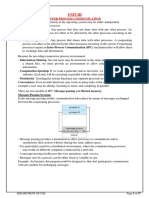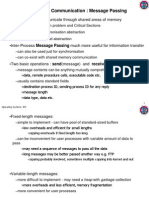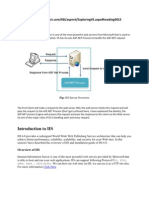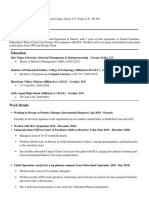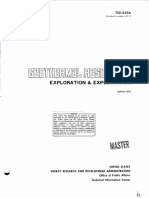ROHINI COLLEGE OF ENGINEERING & TECHNOLOGY
2.4 INTERPROCESS COMMUNICATION
A process is independent if it cannot affect or be affected by the other processes
executing in the system. Any process that does not share data with any other process
is independent.
A process is cooperating if it can affect or be affected by the other processes executing
in the system. Clearly, any process that shares data with other processes is a
cooperating process.
Advantages of cooperating process
i) Information sharing
ii) Computation speedup
iii) Modularity
iv) Convenience.
DEFINITION:
An Inter process communication is a mechanism that allows the cooperating process
to exchange data and communication among each other.
There are two fundamental models of Inter process communication
Shared Memory model
Message passing model
In shared memory model a region of memory is shared by the cooperating process.
Processes can then exchange information by reading and writing data to the shared
region.
In the message-passing model, communication takes place by means of messages
exchanged between the cooperating processes.
Message passing is easier to implement in a distributed system than shared memory.
The shared memory is faster than that of message passing.
CS8493-OPERATING SYSTEMS
� ROHINI COLLEGE OF ENGINEERING & TECHNOLOGY
Communications models: (a) Message passing. (b) Shared memory.
2.4.1 Shared-Memory Systems
Inter process communication using shared memory requires communicating
processes to establish a region of shared memory.
Shared-memory region resides in the address space of the process creating the shared-
memory segment.
Other processes that wish to communicate using this shared-memory segment must
attach it to their address space. They can then exchange information by reading and
writing data in the shared areas.
EXAMPLE: PRODUCER – CONSUMER PROCESS:
A producer process produces information that is consumed by a consumer process.
One solution to the producer–consumer problem uses shared memory
To allow producer and consumer processes to run concurrently, we must have
available a buffer of items that can be filled by the producer and emptied by the
consumer.
This buffer will reside in a region of memory that is shared by the producer and
consumer processes. A producer can produce one item while the consumer is
consuming another item.
Two types of buffers can be used.
CS8493-OPERATING SYSTEMS
� ROHINI COLLEGE OF ENGINEERING & TECHNOLOGY
Bounded Buffer.
Unbounded Buffer.
The unbounded buffer places no practical limit on the size of the buffer. The consumer
may have to wait for new items, but the producer can always produce new items.
The bounded buffer assumes a fixed buffer size. In this case, the consumer must wait
if the buffer is empty, and the producer must wait if the buffer is full.
CODE FOR PRODUCER PROCESS:
item next produced;
while (true) {
/* produce an item in next produced */
while (((in + 1) % BUFFER SIZE) == out);
/* do nothing */
buffer[in] = next produced;
in = (in + 1) % BUFFER SIZE;
}
The producer process has local variable next produced in which the new item to be produced
is stored.
The consumer process has a local variable next consumed in which the item to be consumed
is stored.
This scheme allows at most BUFFER SIZE − 1 items in the buffer at the same time.
CODE FOR CONSUMER PROCESS
item next consumed;
while (true) {
while (in == out); /* do nothing */
/* Get the next available item */
nextConsumed = buffer[ out ];
out = ( out + 1 ) % BUFFER_SIZE;
}
CS8493-OPERATING SYSTEMS
� ROHINI COLLEGE OF ENGINEERING & TECHNOLOGY
2.4.2 Message-Passing Systems
• Message passing systems must support at a minimum system calls for "send
message" and "receive message".
• A communication link must be established between the cooperating processes
before messages can be sent.
• There are three key issues to be resolved in message passing systems
• Direct or indirect communication ( naming )
• Synchronous or asynchronous communication
• Automatic or explicit buffering.
2.4.2.1 Naming
Each process that wants to communicate must explicitly name the recipient or
sender of the communication. Direct communication can be done in two ways symmetric
addressing and asymmetric addressing.
• With direct communication the sender must know the name of the receiver to
which it wishes to send a message.
• There is a one-to-one link between every sender-receiver pair.
• For symmetric communication, the receiver must also know the specific name of
the sender from which it wishes to receive messages.
send(P, message)—Send a message to process P.
receive(Q, message)—Receive a message from process Q.
• For asymmetric communications, this is not necessary.
send(P, message)—Send a message to process P.
receive(id, message)—Receive a message from any process
• Indirect communication uses shared mailboxes, or ports.
send(A, message)—Send a message to mailbox A.
receive(A, message)—Receive a message from mailbox A.
• Multiple processes can share the same mailbox or boxes.
• Only one process can read any given message in a mailbox. Initially the process
that creates the mailbox is the owner, and is the only one allowed to read mail in
the mailbox, although this privilege may be transferred.
The OS must provide system calls to create and delete mailboxes, and to send and receive
messages to/from mailboxes.
CS8493-OPERATING SYSTEMS
� ROHINI COLLEGE OF ENGINEERING & TECHNOLOGY
3.4.2.2 Synchronization
Either the sending or receiving of messages (or neither or both ) may be either blocking or
non-blocking.
Blocking send. The sending process is blocked until the message is received by the
receiving process or by the mailbox
Nonblocking send. The sending process sends the message and resumes Operation
Blocking receive. The receiver blocks until a message is available.
Nonblocking receive. The receiver retrieves either a valid message or a null.
3.4.2.3 Buffering
Messages are passed via queues, which may have one of three capacity configurations:
1. Zero capacity - Messages cannot be stored in the queue, so senders must block until
receivers accept the messages.
2. Bounded capacity- There is a certain pre-determined finite capacity in the queue.
Senders must block if the queue is full, until space becomes available in the queue, but may
be either blocking or non-blocking otherwise.
3. Unbounded capacity - The queue has a theoretical infinite capacity, so senders are
never forced to block.
CS8493-OPERATING SYSTEMS

























